Fiberglass Pools Utah
Top-quality fiberglass pool installations, done right first time!



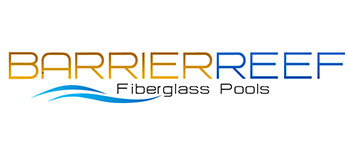
Choosing a Swimming Pool in Utah
Choosing a Pool Builder in Utah
Choosing a Swimming Pool in Utah
Choosing the right swimming pool for your Utah home is a major decision you want to make with the most information and guidance. After all, this is the space where your family will make memories, the destination for entertaining with friends and decompressing after a long day. So your Utah pool needs to provide all of the elements you want with the highest degree of durability and ease of maintenance.
One of the biggest decisions you’ll make is whether to opt for a fiberglass pool or a gunite (shotcrete) concrete pool. We’ll explore the factors which go into this choice as well as other factors to consider.
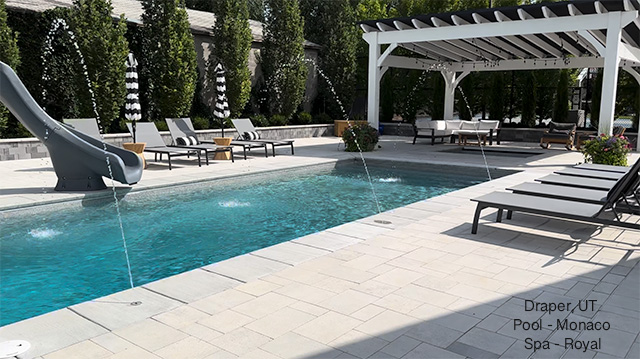
Your Pool Choice Begins with Your Utah Location
First, when choosing a swimming pool installation in UT, you’ll want to consider the specific area of Utah where your pool will be installed. For Northern Utah homes, where winter freezing conditions are common, a drop-in fiberglass swimming pool is recommended due to its durability and weather-resistance. Fiberglass pools can stand up to both the freezing temperatures of winter as well as the heat of the summer sun.
If you live in southern Utah, you probably don’t have to worry about freezing conditions, so a gunite concrete pool is also an option. Choosing a fiberglass pool or a gunite (shotcrete) concrete pool is a decision which is based on many factors such as cost, affordability, and specific pool design requirements. The specific layout of your backyard will also factor into this process, since some landscape obstacles like tall trees, power lines, or buildings may make it impossible for a crane to install a fiberglass pool into your backyard.
Salt Water Systems and Pool Materials
Salt water backyard pool systems have become quite popular over the last decade and for good reason. Salt systems use far less chlorine, so the water is more gentle on the eyes, skin, and hair. Salt systems also keep the water cleaner in a more efficient manner, requiring far less testing without the need for storing and handling chemicals.
But while salt systems may be gentler on our bodies, salt is not so nice to concrete. Just as a driveway gets ruined with the continual use of salt for deicing, so too can gunite pools deteriorate from constant exposure to salt. This means that a chemical-free salt system is only suitable for fiberglass pools. Some gunite pool owners in Utah still choose to have a salt system in their concrete pools, despite the future costly repairs required for the concrete surface. In an attempt to protect the concrete gunite pool from the corrosive effects of salt, Utah pool builders may cover the concrete pool surface with concrete protective compounds. While this option may work in Southern Utah, it is not recommended in areas that experience freezing conditions, such as in Northern Utah.
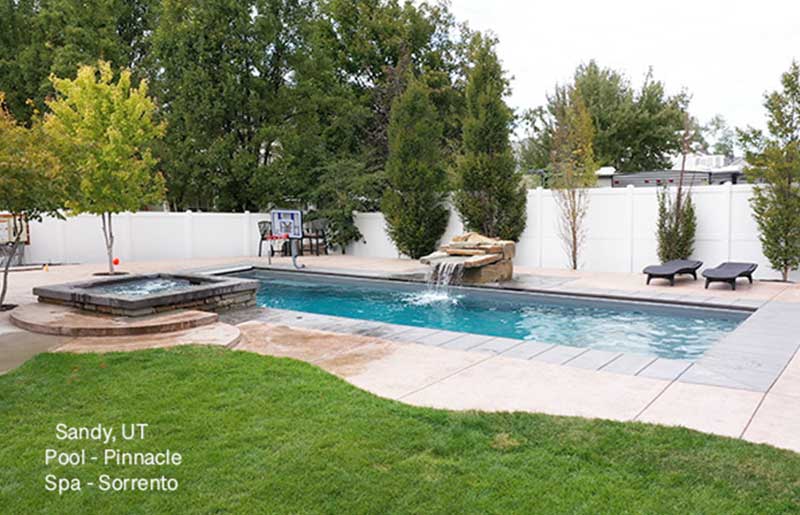
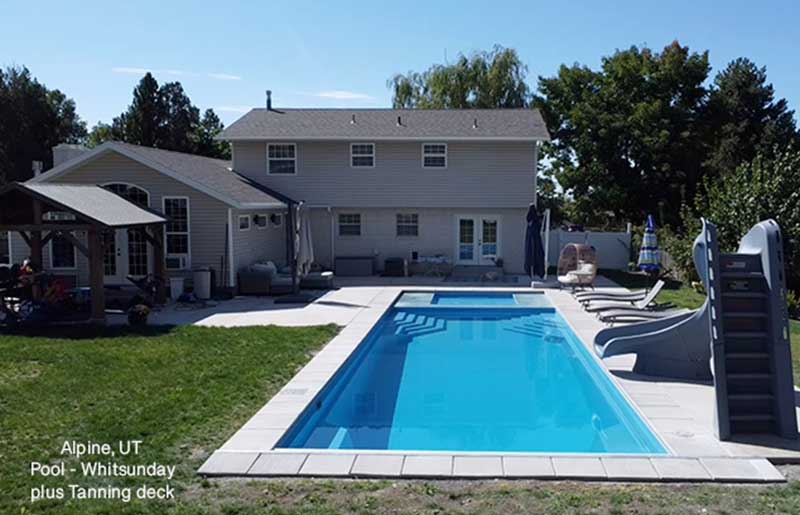
Ground Precautions to Understand for Installing Utah Swimming Pools
Ground conditions in Utah can vary dramatically. When excavating the ground for a swimming pool, an installer will often encounter various types of soil, gravel, sand, rocks, and high levels of underground water.
These ground conditions can be stabilized using different materials, whichever type of pool you’ve chosen. However, special attention is required for one type of ground in Southern Utah – red clay. Red clay is extremely difficult to compact properly and tends to shift when moisture is present. In these instances, soil engineering will need to be conducted, and it is likely that concrete piers and beams will need to be installed before constructing any type of swimming pool.
Fiberglass Pool Benefits
– Durability –
Think of a fiberglass like a bulletproof vest for your pool. Perfected over many years of innovative engineering, fiberglass pool manufacturers have created highly durable surface compounds which help extend the life of your pool. This structural integrity ensures your fiberglass swimming pool can withstand decades of enjoyment with minimal need for repairs.
Both durable and low-maintenance, the non-porous surface of a fiberglass pool helps prevent algae growth while also ensuring that it can withstand extreme weather conditions. However, homeowners need to be aware that the structural integrity of a fiberglass pool is only as reliable as the installation process. Incorrect installation can lead to ground shifts over time, potentially cracking not just a fiberglass pool, but a concrete gunite pool as well. This is why the expertise and experience of a pool installer plays a crucial role in the longevity of any pool. Although it’s important to choose the pool material that’s right for you, one of the most critical decisions you’ll make in terms of pool durability is selecting the right pool installer.
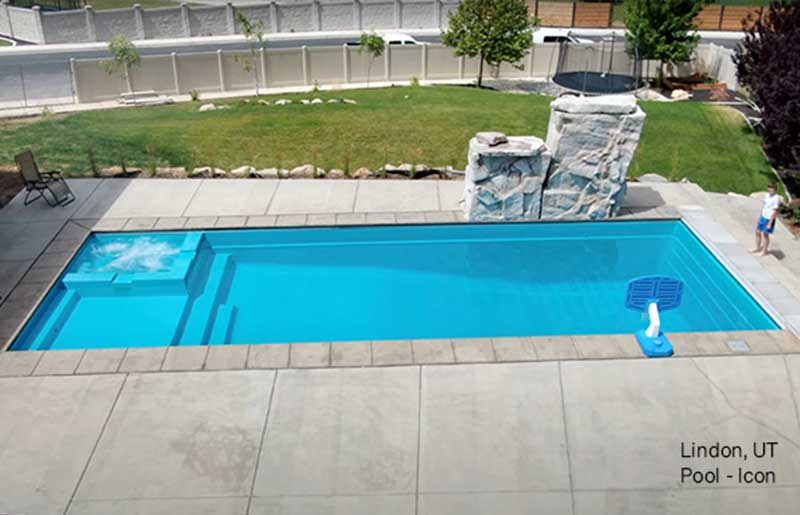
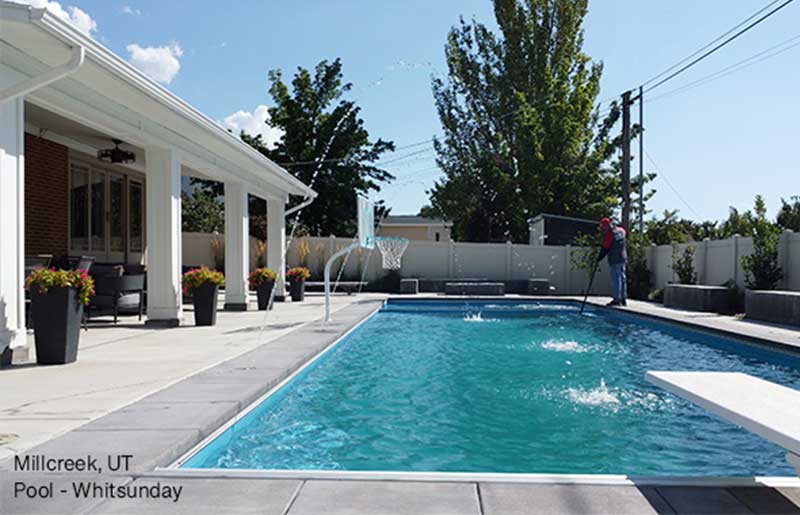
– Pool Maintenance –
One of the reasons fiberglass pool owners are so fond of their pools is the low maintenance they require. Fiberglass pools can easily be brought back to pristine condition with minimal effort, even after periods of neglect. The almost self-sufficient nature of fiberglass pools is a testament to their design and the convenience they offer to homeowners.
According to some clients, it’s easier to keep a large salt water fiberglass pool clean than it is a tiny hot tub. This comparison highlights the ease of maintenance associated with fiberglass swimming pools, further enhancing their appeal.
– Efficiency –
Unlike concrete, fiberglass pools insulate pool water from the cold ground. This provides significant benefits, shielding your pool from the cold ground, which makes it much more efficient and economical to heat a fiberglass pool in colder temperatures. In a fiberglass pool, the water retains warmth long after the heater is turned off, and in summer, the sun’s rays naturally warm the pool, especially under the pool cover. In fact, very dark pool covers are not recommended for fiberglass pools due to the potential for overheating.
– Safety –
The surface of a fiberglass pool is designed with safety in mind, ensuring it’s kid-friendly and free from abrasive structures that could cause harm during prolonged pool use. This safety feature, coupled with the warmth of the water, makes fiberglass pools a preferred choice for families, eliminating the need for pool shoes required in concrete gunite pools.
– Surface –
Despite their smooth texture, fiberglass pools feature a gelcoat surface engineered to be slip-resistant. This addition is crucial for safety in wet areas like pool steps and ledges. Over time, any initial slipperiness, possibly due to manufacturing wax or body lotions, diminishes, further ensuring the pool’s safety. For additional slip prevention, pool owners can opt for non-slip mats or decals, which adhere well to the fiberglass surface.
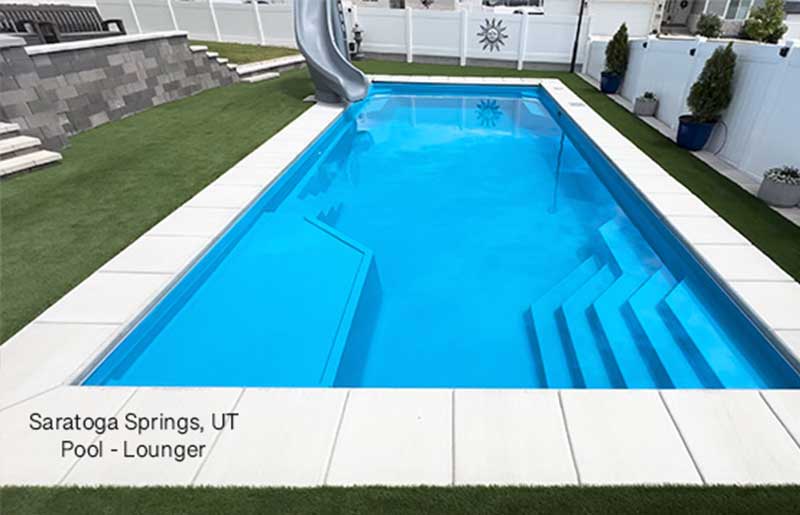
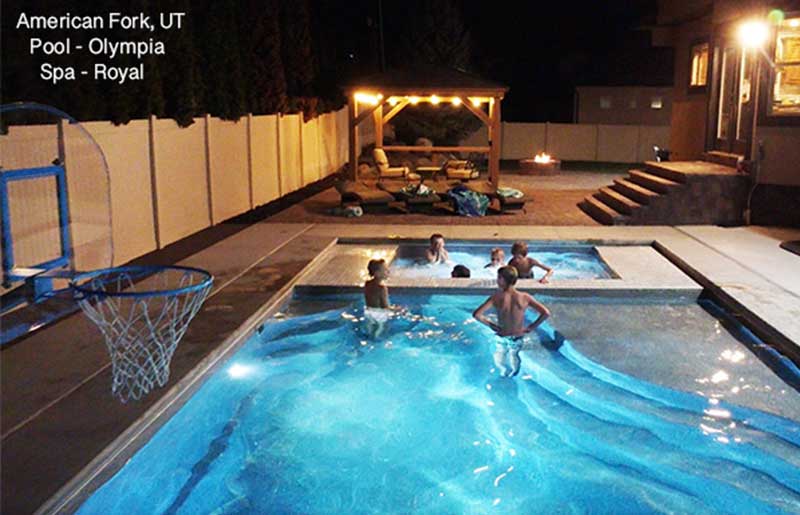
– Health –
Fiberglass pools, beyond their aesthetic and practical advantages, significantly contribute to health and wellness. Regular access to a swimming pool promotes a fun and engaging form of physical activity, vital for stress management and overall well-being. Swimming is known to decrease the body’s stress hormones and increase the production of endorphins, enhancing mood and reducing feelings of stress. Swimming is also one of the methods of cardio exercise that doctors recommend frequently thanks to its low-impact nature, which allows everyone, from children to the elderly, to enjoy.
Fiberglass pools require fewer chemicals compared to other types of pools, reducing swimmers’ exposure to potentially harmful substances. Pools often serve as a communal space for family and friends, providing social benefits and improving emotional well-being.
– Ease of Use –
Fiberglass pools do not require extensive pool preparation for upcoming events or short notice family gatherings. Depending on the fiberglass pool design, the pool vacuum may already have the fiberglass pool ready to enjoy. Most fiberglass pools can be heated within a few hours, the same, however, cannot be said about gunite pools. With a fiberglass pool you’ll have more time to focus on your family gatherings and more opportunities to enjoy your pool and the entertainment possibilities it creates.
Compare that to gunite pool owners who need to drop everything in order to get their pool ready for guests to arrive, this includes the dirty job of scrubbing yards of rough gunite surfaces, adding chemicals, and testing the water, just to make it swim-ready. For these gunite pool owners, the only alternative is hiring a pool maintenance service, but these types of services may not be available on short notice.
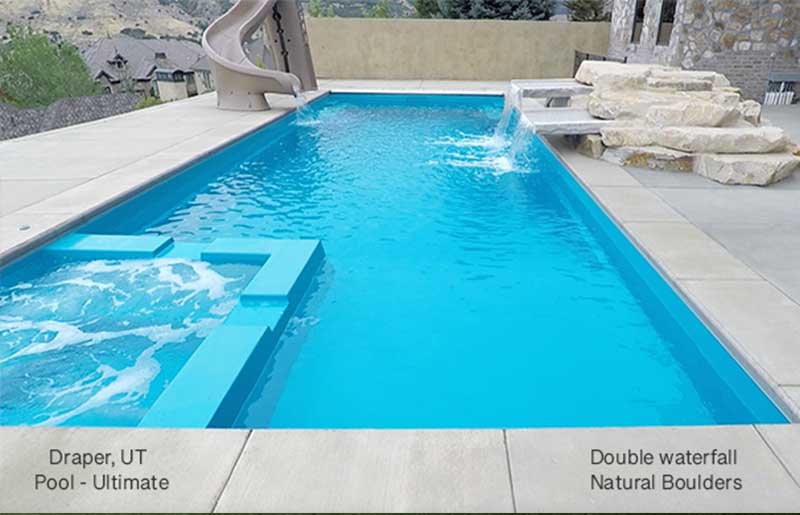

Southern Utah Pool Choices vs. Northern Utah Pool Options
The differing climates of southern Utah compared to northern Utah matters when it comes to pool selection and how you’ll use your new pool.
In Southern Utah there are no freezing winter conditions to worry about. Summers can be very hot however. This makes fiberglass pools with shallow tanning decks or ledges very popular in this region.
In contrast, northern Utah enjoys a full range of all four seasons including cold winters and hot summers. Here, homeowners tend to prefer deeper pools which allow for greater submerging into the warm water, which is particularly inviting on chilly evenings or during those cool spring winds. This type of deep pool also lends itself to a greater spectrum of activities such as swimming, diving, and jumping.
Deep pools are safe for diving and a well-outfitted pool can enhance the exhilarating fun. If you opt for such a pool, you probably won’t be satisfied with just a jumping board. Today’s deep fiberglass pools can be enhanced with various jumping platforms, waterfalls, and inviting cascading slides. Finish the look with the support of natural boulders or artificial rocks.
If you live in northern Utah, you probably want to prolong the pool season as much as possible. Thankfully there are many options for extending that summer fun. Swapping out a light colored pool cover for a darker pool cover will substantially increase the water temperature from the sun. Installing a pool heater in close proximity to your pool also helps to reduce the costs of pool heating during the colder months.
No matter where you are in Utah, one thing is for sure – it’s pretty hard to avoid Utah’s hot, sunny summers. Since Utah enjoys more sunny days than many states in the US, sun is a factor to consider when picking your pool location. Allowing a pool to receive some shade, whether from foliage or the placement of your home can be a wise decision. If this isn’t possible, the addition of umbrellas and sunshades can make staying in the pool longer more feasible during the peak of daylight.
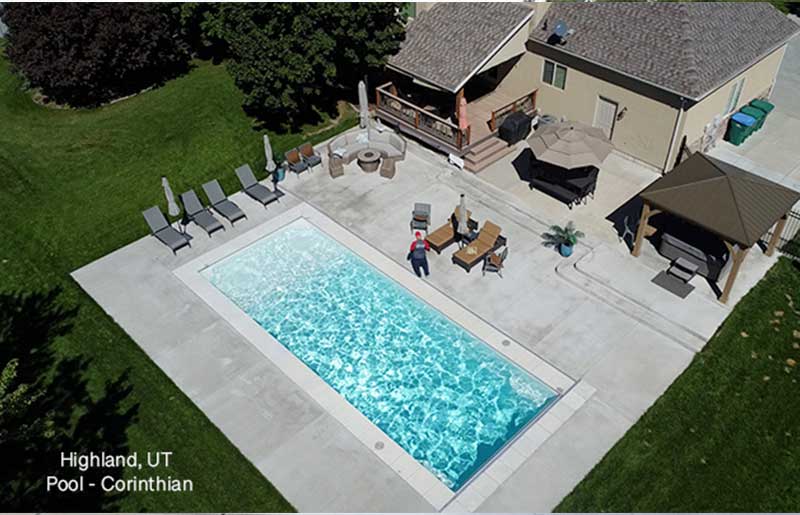
Choosing a Pool Builder in Utah
When you’re choosing a fiberglass pool builder in Utah, there are many important factors to consider. Since we have decades of experience in fiberglass pool installation, we’ve created this checklist of steps to take when you’re searching for the right pool builder in Utah. Although it may take a bit of research, your pool is an investment that shouldn’t be left to chance. The lifespan, durability, and overall enjoyment and satisfaction depend on the experience and know-how of your pool builder. That’s why it’s important to take your time, do your homework and choose wisely. You can begin the process by following these steps:
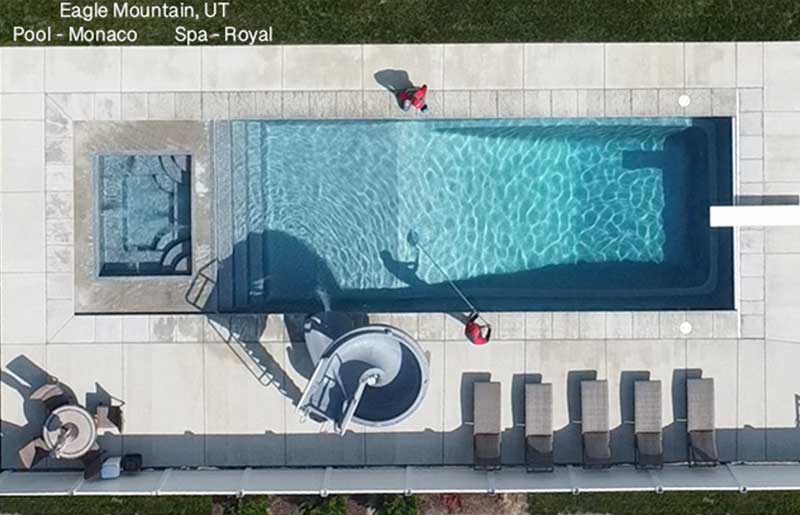
- Research Local Pool Builders: Start by researching reputable fiberglass pool builders in Utah. Look for pool companies with a strong track record of satisfied customers, positive reviews, and experience in building fiberglass pools, ensuring you're working with a top pool builder.
- Check Credentials and Experience: Verify the credentials and experience of the pool builders in Utah you’re considering. Ensure they are licensed, bonded, and insured to perform pool construction in the state. Additionally, you’ll want to inquire about each pool builder’s experience building fiberglass pools and asking for references or examples of past projects.
- Review Portfolios and Testimonials: Take the time to review the portfolios and testimonials of prospective pool builders in Utah. Look for photos of completed fiberglass pool installations that showcase their craftsmanship, attention to detail, and design capabilities. Reading testimonials from satisfied customers can also provide valuable insights into the builder's professionalism, communication, and customer service. Beyond past work, it’s also a good idea to see if you are able to speak to a current client who is currently receiving a pool installation. This will give you a better feel for how a builder handles this process and you’ll gain first-hand insight into what life looks like during construction.
- Ask About Design and Customization Options: Discuss your vision for the fiberglass pool design and any specific customization options you're interested in with potential builders in Utah. Inquire about their design process, ability to accommodate your preferences, and options for custom features such as waterfalls, lighting, or built-in spas. A skilled pool builder should be able to translate your ideas into a tailored design that meets your needs and budget. Since fiberglass pool builders work with fiberglass pool manufacturers, you’ll want to choose a builder who has done the work to be a qualified partner with a number of manufacturers so you have the most options available to you.
- Get Multiple Quotes: Obtain detailed quotes from multiple pool builders in Utah to compare pricing, services, and included features for fiberglass pool installation. Be sure to ask about any additional costs or potential factors that may affect the final price, such as site preparation, permits, or landscaping. While cost is an important factor, prioritize value and quality when making your decision.
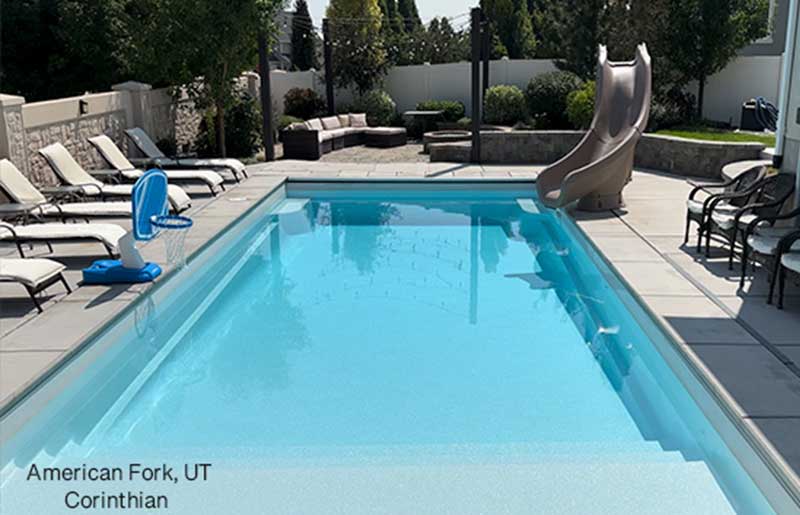
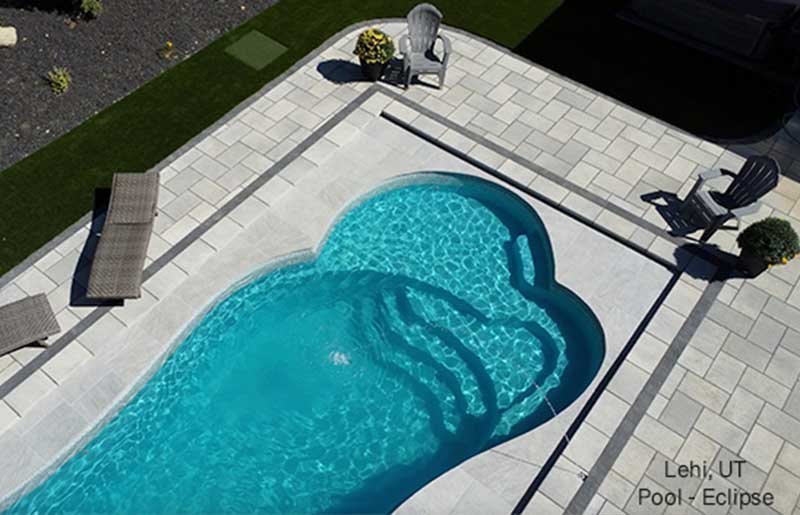
- Ask About Timelines and Warranty: Inquire about the estimated timeline for the fiberglass pool installation project from start to finish, including construction, inspections, and final completion. Additionally, ask about the builder's warranty coverage for materials, workmanship, and equipment, including pool warranty and warranty terms. A reputable pool builder in Utah should stand behind their work and offer a comprehensive warranty to protect your investment.
- Check for Proper Licensing and Insurance: Ensure that the pool builder in Utah holds the necessary licenses and insurance coverage required by the state. This includes general liability insurance, worker's compensation insurance, and any specific licenses or permits for fiberglass pool installation.
- Communicate Clearly and Establish Expectations: Effective communication is key to a successful fiberglass pool installation experience. Choose a pool builder in Utah who listens to your needs, communicates openly and transparently, and keeps you informed throughout every stage of the project. Establish clear expectations regarding timelines, budget, design changes, and any other relevant details to avoid misunderstandings or delays.
- Visit Completed Projects and Ask for Referrals: If possible, visit completed fiberglass pool installation projects or ask for referrals from satisfied customers in Utah to see the builder's work firsthand. This can provide valuable insights into the quality of construction, attention to detail, and overall customer satisfaction.
- Trust Your Instincts: Ultimately, trust your instincts when choosing a fiberglass pool builder in Utah for the installation of your fiberglass pool. Select a builder who inspires confidence, demonstrates professionalism, and shares your vision for creating the perfect swimming pool for your home. By taking the time to research, ask questions, and compare options, you can find a reputable pool builder in Utah who will bring your dream pool to life with skill, expertise, and dedication.

Contact
Get A Free Consultation!
We’ll assess your backyard, recommend the best pool spot, check installation access, and give you an accurate quote
all at no cost!
Text us for a quick respose – we’re always on site!
Draper, UT
Send The Form
Areas We Serve
Looking for a pool installation company in Utah? Look no further!
We specialize in bringing sparkling pools to homeowners throughout Northern Utah, including
Draper | Herriman | Highland | SALT LAKE COUNTY | Bluffdale | Cottonwood Heights | Holladay | Midvale | Millcreek | Murray | Riverton | Salt Lake City | Sandy | South Jordan | Taylorsville | West Jordan | West Valley City | UTAH COUNTY | Alpine | American Fork | Cedar Hills | Eagle Mountain | Lehi | Lindon | Provo | Saratoga Springs | Mapleton | Spanish Fork | Highland | Orem | Springville | Vinyard | DAVIS COUNTY | Bountiful | Centerville | Clearfield | Clinton | Farmington | Fruit Heights | Kaysville | Layton | North Salt Lake | South Weber | Sunset | Syracuse | West Bountiful | West Point | Woods Cross | WEBER COUNTY | Ogden | Riverdale | Roy | South Ogden